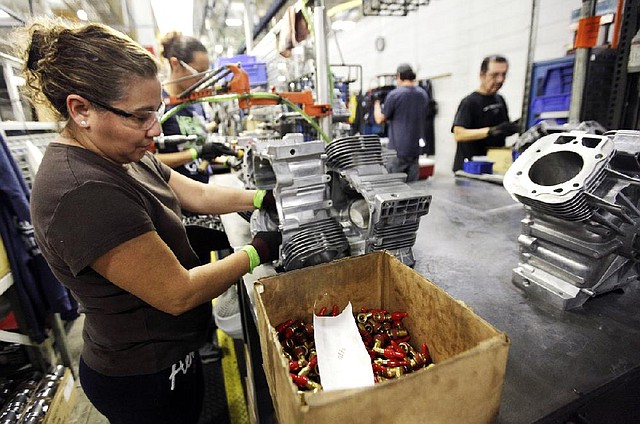U.S. manufacturing up 1.1% as auto output jumps 4.5%
Sherle Mir works on an assembly line at Generac Power Systems Inc., one of the largest U.S. makers of residential generators, in Whitewater, Wis. The Federal Reserve said Friday that factory output increased 1.1 percent in November from October.
Saturday, December 15, 2012
WASHINGTON — U.S. factories rebounded in November, increasing production of cars, equipment and appliances.
The Federal Reserve said Friday that factory output increased 1.1 percent in November from October. That offset a 1 percent decline in the previous month, which was blamed on superstorm Sandy.
Auto production jumped 4.5 percent last month, the first increase since July. Production of primary metals, wood products, electrical equipment and appliances all showed gains.
Total industrial output at factories, mines and utilities also rose 1.1 percent last month, after a 0.7 percent decline in October.
Still, economists cautioned that the rebound in manufacturing was almost entirely related to the storm.
Sal Guatieri, senior economist at BMO Capital Markets, based in Toronto, said that when averaging data over October and November, industrial output and manufacturing both were up just 2.1 percent over the past year — less than half the growth rate from the start of the year.
“Looking beyond Sandy’s impact, U.S. manufacturers continue to plod ahead,” Guatieri said.
Many companies have delayed purchases of machinery and equipment this year because of uncertainty surrounding taxes and government spending. They are also worried about a slowdown in global growth that has weighed on U.S. exports.
“The global slowdown will prevent a strong recovery” in manufacturing, predicted Paul Dales, senior economist at Capital Economics.
U.S. manufacturing activity shrank in November to the slowest pace since July 2009, according to a closely watched index of manufacturing activity compiled by the Institute for Supply Management.
The deadlock over the federal budget remains a hurdle for American factories as a failure to avert tax increases and spending cuts, known as the “fiscal cliff,” is projected to trigger a recession.
“The outlook for the back half of 2013 is actually not that bad,” as long as lawmakers reach a budget deal, said Carl Riccadonna, a senior U.S. economist at Deutsche Bank Securities Inc. in New York. “We do have decent job gains, decent income gains, consumer spending is holding up and housing is turning around. You could easily see a constructive profile for the economy.”
A steep drop in the price of gasoline pushed down a measure of U.S. consumer prices last month, keeping inflation mild.
The seasonally adjusted consumer price index dropped 0.3 percent in November from October, the Labor Department said Friday. Gasoline prices fell 7.4 percent, the biggest drop in nearly four years. That offset a 0.2 percent rise in food prices.
In the past year, consumer prices have risen 1.8 percent, down from October’s 12-month increase of 2.2 percent.
Excluding the volatile food and gas categories, prices ticked up 0.1 percent in November. Core prices have risen 1.9 percent in the past year — below the Federal Reserve’s annual target of 2 percent.
Higher rents, airline fares and new cars pushed up core prices last month. The cost of clothing and used cars fell.
“In simplest terms, inflation is not a problem,” Jim Baird, chief investment strategist at Plante Moran Financial Advisors, said. Lower inflation “is a real positive that should provide modest relief for households dealing with limited income growth.”
High unemployment and slow wage growth have made businesses reluctant to raise prices. Many worry higher prices could drive away customers. That’s helped keep inflation tame.
Gasoline prices have fallen sharply in the past two months after spiking in late summer. A gallon of gasoline cost an average of $3.29 nationwide Friday. That’s 15 cents less than a month ago and 50 cents less than in mid-October. In Arkansas, the average price of a gallon of gasoline Friday was $3.095, according to travel club AAA.
The increase in food prices was smaller than many economists expected. This summer’s drought in the Midwest, which scorched corn and soybean crops, has pushed up food prices. But the increase hasn’t been dramatic so far. Food costs have risen 1.8 percent in the past 12 months.
Information for this article was contributed by Martin Crutsinger and Christopher S. Rugaber of The Associated Press and by Alex Kowalski, Lorraine Woellert and Chris Middleton of Bloomberg News.
Business, Pages 27 on 12/15/2012
